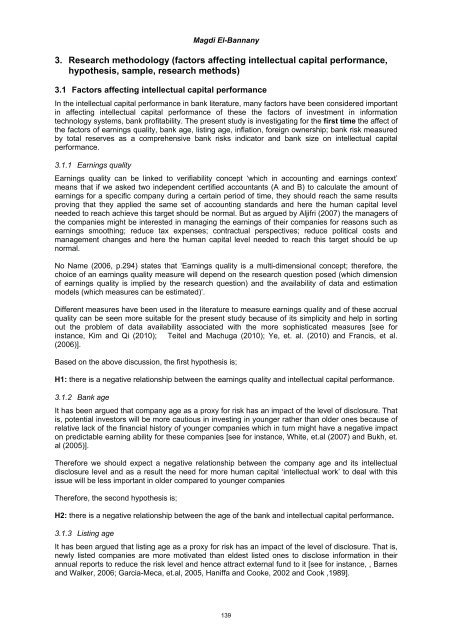Proceedings of the 3rd European Conference on Intellectual Capital
Proceedings of the 3rd European Conference on Intellectual Capital
Proceedings of the 3rd European Conference on Intellectual Capital
You also want an ePaper? Increase the reach of your titles
YUMPU automatically turns print PDFs into web optimized ePapers that Google loves.
Magdi El-Bannany<br />
3. Research methodology (factors affecting intellectual capital performance,<br />
hypo<str<strong>on</strong>g>the</str<strong>on</strong>g>sis, sample, research methods)<br />
3.1 Factors affecting intellectual capital performance<br />
In <str<strong>on</strong>g>the</str<strong>on</strong>g> intellectual capital performance in bank literature, many factors have been c<strong>on</strong>sidered important<br />
in affecting intellectual capital performance <str<strong>on</strong>g>of</str<strong>on</strong>g> <str<strong>on</strong>g>the</str<strong>on</strong>g>se <str<strong>on</strong>g>the</str<strong>on</strong>g> factors <str<strong>on</strong>g>of</str<strong>on</strong>g> investment in informati<strong>on</strong><br />
technology systems, bank pr<str<strong>on</strong>g>of</str<strong>on</strong>g>itability. The present study is investigating for <str<strong>on</strong>g>the</str<strong>on</strong>g> first time <str<strong>on</strong>g>the</str<strong>on</strong>g> affect <str<strong>on</strong>g>of</str<strong>on</strong>g><br />
<str<strong>on</strong>g>the</str<strong>on</strong>g> factors <str<strong>on</strong>g>of</str<strong>on</strong>g> earnings quality, bank age, listing age, inflati<strong>on</strong>, foreign ownership; bank risk measured<br />
by total reserves as a comprehensive bank risks indicator and bank size <strong>on</strong> intellectual capital<br />
performance.<br />
3.1.1 Earnings quality<br />
Earnings quality can be linked to verifiability c<strong>on</strong>cept ‘which in accounting and earnings c<strong>on</strong>text’<br />
means that if we asked two independent certified accountants (A and B) to calculate <str<strong>on</strong>g>the</str<strong>on</strong>g> amount <str<strong>on</strong>g>of</str<strong>on</strong>g><br />
earnings for a specific company during a certain period <str<strong>on</strong>g>of</str<strong>on</strong>g> time, <str<strong>on</strong>g>the</str<strong>on</strong>g>y should reach <str<strong>on</strong>g>the</str<strong>on</strong>g> same results<br />
proving that <str<strong>on</strong>g>the</str<strong>on</strong>g>y applied <str<strong>on</strong>g>the</str<strong>on</strong>g> same set <str<strong>on</strong>g>of</str<strong>on</strong>g> accounting standards and here <str<strong>on</strong>g>the</str<strong>on</strong>g> human capital level<br />
needed to reach achieve this target should be normal. But as argued by Aljifri (2007) <str<strong>on</strong>g>the</str<strong>on</strong>g> managers <str<strong>on</strong>g>of</str<strong>on</strong>g><br />
<str<strong>on</strong>g>the</str<strong>on</strong>g> companies might be interested in managing <str<strong>on</strong>g>the</str<strong>on</strong>g> earnings <str<strong>on</strong>g>of</str<strong>on</strong>g> <str<strong>on</strong>g>the</str<strong>on</strong>g>ir companies for reas<strong>on</strong>s such as<br />
earnings smoothing; reduce tax expenses; c<strong>on</strong>tractual perspectives; reduce political costs and<br />
management changes and here <str<strong>on</strong>g>the</str<strong>on</strong>g> human capital level needed to reach this target should be up<br />
normal.<br />
No Name (2006, p.294) states that ‘Earnings quality is a multi-dimensi<strong>on</strong>al c<strong>on</strong>cept; <str<strong>on</strong>g>the</str<strong>on</strong>g>refore, <str<strong>on</strong>g>the</str<strong>on</strong>g><br />
choice <str<strong>on</strong>g>of</str<strong>on</strong>g> an earnings quality measure will depend <strong>on</strong> <str<strong>on</strong>g>the</str<strong>on</strong>g> research questi<strong>on</strong> posed (which dimensi<strong>on</strong><br />
<str<strong>on</strong>g>of</str<strong>on</strong>g> earnings quality is implied by <str<strong>on</strong>g>the</str<strong>on</strong>g> research questi<strong>on</strong>) and <str<strong>on</strong>g>the</str<strong>on</strong>g> availability <str<strong>on</strong>g>of</str<strong>on</strong>g> data and estimati<strong>on</strong><br />
models (which measures can be estimated)’.<br />
Different measures have been used in <str<strong>on</strong>g>the</str<strong>on</strong>g> literature to measure earnings quality and <str<strong>on</strong>g>of</str<strong>on</strong>g> <str<strong>on</strong>g>the</str<strong>on</strong>g>se accrual<br />
quality can be seen more suitable for <str<strong>on</strong>g>the</str<strong>on</strong>g> present study because <str<strong>on</strong>g>of</str<strong>on</strong>g> its simplicity and help in sorting<br />
out <str<strong>on</strong>g>the</str<strong>on</strong>g> problem <str<strong>on</strong>g>of</str<strong>on</strong>g> data availability associated with <str<strong>on</strong>g>the</str<strong>on</strong>g> more sophisticated measures [see for<br />
instance, Kim and Qi (2010); Teitel and Machuga (2010); Ye, et. al. (2010) and Francis, et al.<br />
(2006)].<br />
Based <strong>on</strong> <str<strong>on</strong>g>the</str<strong>on</strong>g> above discussi<strong>on</strong>, <str<strong>on</strong>g>the</str<strong>on</strong>g> first hypo<str<strong>on</strong>g>the</str<strong>on</strong>g>sis is;<br />
H1: <str<strong>on</strong>g>the</str<strong>on</strong>g>re is a negative relati<strong>on</strong>ship between <str<strong>on</strong>g>the</str<strong>on</strong>g> earnings quality and intellectual capital performance.<br />
3.1.2 Bank age<br />
It has been argued that company age as a proxy for risk has an impact <str<strong>on</strong>g>of</str<strong>on</strong>g> <str<strong>on</strong>g>the</str<strong>on</strong>g> level <str<strong>on</strong>g>of</str<strong>on</strong>g> disclosure. That<br />
is, potential investors will be more cautious in investing in younger ra<str<strong>on</strong>g>the</str<strong>on</strong>g>r than older <strong>on</strong>es because <str<strong>on</strong>g>of</str<strong>on</strong>g><br />
relative lack <str<strong>on</strong>g>of</str<strong>on</strong>g> <str<strong>on</strong>g>the</str<strong>on</strong>g> financial history <str<strong>on</strong>g>of</str<strong>on</strong>g> younger companies which in turn might have a negative impact<br />
<strong>on</strong> predictable earning ability for <str<strong>on</strong>g>the</str<strong>on</strong>g>se companies [see for instance, White, et.al (2007) and Bukh, et.<br />
al (2005)].<br />
Therefore we should expect a negative relati<strong>on</strong>ship between <str<strong>on</strong>g>the</str<strong>on</strong>g> company age and its intellectual<br />
disclosure level and as a result <str<strong>on</strong>g>the</str<strong>on</strong>g> need for more human capital ‘intellectual work’ to deal with this<br />
issue will be less important in older compared to younger companies<br />
Therefore, <str<strong>on</strong>g>the</str<strong>on</strong>g> sec<strong>on</strong>d hypo<str<strong>on</strong>g>the</str<strong>on</strong>g>sis is;<br />
H2: <str<strong>on</strong>g>the</str<strong>on</strong>g>re is a negative relati<strong>on</strong>ship between <str<strong>on</strong>g>the</str<strong>on</strong>g> age <str<strong>on</strong>g>of</str<strong>on</strong>g> <str<strong>on</strong>g>the</str<strong>on</strong>g> bank and intellectual capital performance.<br />
3.1.3 Listing age<br />
It has been argued that listing age as a proxy for risk has an impact <str<strong>on</strong>g>of</str<strong>on</strong>g> <str<strong>on</strong>g>the</str<strong>on</strong>g> level <str<strong>on</strong>g>of</str<strong>on</strong>g> disclosure. That is,<br />
newly listed companies are more motivated than eldest listed <strong>on</strong>es to disclose informati<strong>on</strong> in <str<strong>on</strong>g>the</str<strong>on</strong>g>ir<br />
annual reports to reduce <str<strong>on</strong>g>the</str<strong>on</strong>g> risk level and hence attract external fund to it [see for instance, , Barnes<br />
and Walker, 2006; Garcia-Meca, et.al, 2005, Haniffa and Cooke, 2002 and Cook ,1989].<br />
139
















